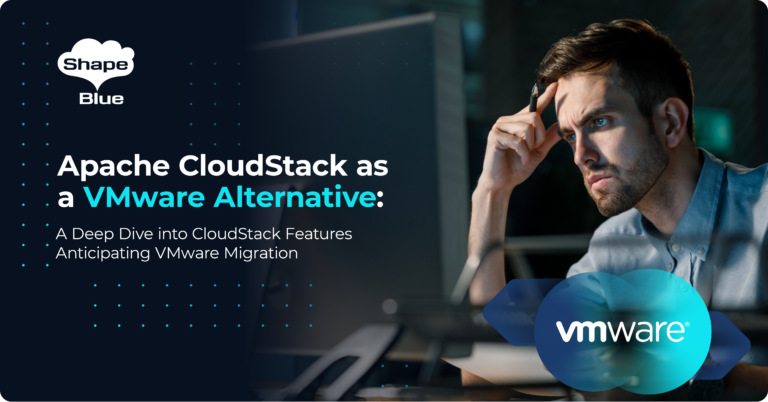Giles Sirett, CEO of ShapeBlue the Cloud specialists, gives his opinion on the recent news that Apache CloudStack has graduated to a Top level Apache project.
You can read the full the full story, here, but in summary, the Apache Software Foundation (ASF) today released this :
The Apache Software Foundation (ASF), the all-volunteer developers, stewards, and incubators of nearly 150 open source projects and initiatives, announced today that Apache CloudStack has graduated from the Apache Incubator to become a Top-Level Project (TLP), signifying that the project’s community and products have been well-governed under the ASF’s meritocratic process and principles
“When CloudStack first became an Apache Incubator project, it was a well-established cloud management platform, so its codebase was already mature,” said Chip Childers, Vice President of Apache CloudStack. “Our work in the Incubator has focused on growing a really strong community around the code and establishing the governance practices expected of a top level project within the Apache Software Foundation.”
This is hugely significant news for both the CloudStack project /community but also for the wider cloud management platform (CMP) space . Most people have worked out by now that there is a bit of a battle going on over CMP’s. But why is this news so significant ?
I’m going to presume that readers understand the face-value significance of this news: Apache CloudStack is now deemed, by Apache, to be a well-governed project with a mature, well-established, community of developers. I can vouch for that: I’ve been involved in the community for some time (there is a disclosure in there somewhere!). Having this seal of approval from Apache should not be taken lightly: their governance structure has been shown time and time again to deliver hugely significant software (Apache webserver, Tomcat, Hadoop, the list goes on) and it has taken an entire year for the project to pass through Apache’s incubation. A whole year, which mainly focussed on community & governance (remember, the product was already established).
But it’s the story behind the headline which, I feel, really has the significance here. The CMP space is a, if not THE, key current battleground in the fight for market share by many software vendors. A decade or so ago, the companies that dominated the server operating system, found it much easier to gain market share in server platforms (take the meteoritic rise of Microsoft’s [at the time] sub-standard SQL Server against Oracle as the perfect example). Roll forward a few years and it was all about the company that “owned” the virtualisation layer: whatever the vendors told us about neutrality and openness, it was always going to be easier for them to make money “up the stack” if they owned the hypervisor layer. Desktop virtualisation simply amplified this battle.
So, bringing this up to 2013, we now have CMP’s, which some are already calling Cloud OS’s. By the simple fact that these technologies abstract infrastructure even further away from IT operations, much like standardised server OS’s and virtualisation did in the past, they become hugely significant for the vendors that want to develop on top of the infrastructure stack.
The other thing here is that its become apparent that, to survive as a CMP, a technology has to have significant momentum – people want to align and nobody wants to back the Cloud Betamax. Such significant momentum will only be gained through the development of a major community of open source developers. Many of these developers are sponsored by the vendors, but the key thing is one vendor can’t do it alone. Vendors who have tried to take on the CMP space with a proprietary offering (think Microsoft, think VMWare) will find this out to their peril.
So, we currently have two significant players in this space : OpenStack & CloudStack (sorry Eucalyptus and Openebula, the space isn’t big enough for 4 projects in my opinion). OpenStack and CloudStack are two similar projects, with similar functionality & use-case’s. It is the different approach that the backers of each of these communities have taken, that really shows the significance of todays news from Apache. Openstack’s primary backer to date has been Rackspace. They have done an excellent job of positioning the technology as the most significant CMP project: lots of marketing ,lots of events and some pretty significant stories about big-name adoption. However, many of us have had the view for some time that OpenStack, despite having a great future, has been over-hyped in terms of what it can deliver today.
CloudStack has come from a different background. It started as a product not a project, it has many real-world large-scale deployments and is proven to be scalable & reliable. It doesn’t have the hype of OpenStack, but it is good technology that works, today. The problem with CloudStack has been that, due to the fact that its previous owners (Citrix) were the main backer, it has been perceived (incorrectly) by many as Citrix open-washing. Today’s announcement should remove any doubt about that perception. The Apache Foundation’s governance model simply would not allow a single vendor to have control of a project – and I think the IT world will sit up and take notice of this.
This decision by ASF is supported by the figures: some recent research by Sebatien Goasguen shows the project having 722 active contributors from 272 different organisations. This says to me : a mature and diverse community, not under a vendors control.
There is a downside of being an Apache project: as the Apache Software Foundation is so tight around governance, it can often stop the big backers of a project from shouting about it too much (like Rackspace did with OpenStack). All decisions around the projects day to day are taken on public mailing lists and run on a true open democratic basis. This includes marketing decisions.The result? – CloudStack has not been as well marketed as it should have been.
I do believe that there will not be a single winner in this space: I believe that CloudStack & OpenStack have both got the required momentum and backing now in order to flourish. I hope they flourish together and side by side. However, I do think it’s time that CloudStack started to get its fair share of the attention and being a Top-Level Apache project should go some ways towards achieving that.
Giles is CEO and founder of ShapeBlue and is responsible for overall company strategy, strategic relationships, finance and sales.
He is also a committer and PMC member of the Apache CloudStack project, and Chairman of the European Cloudstack User Group, actively helping promote brand awareness of the technology.




